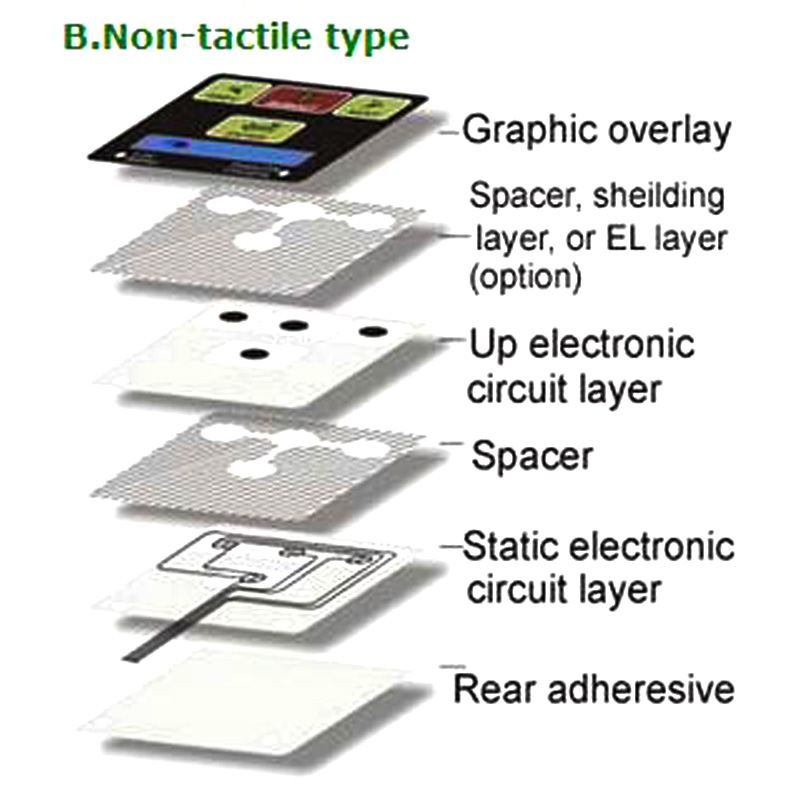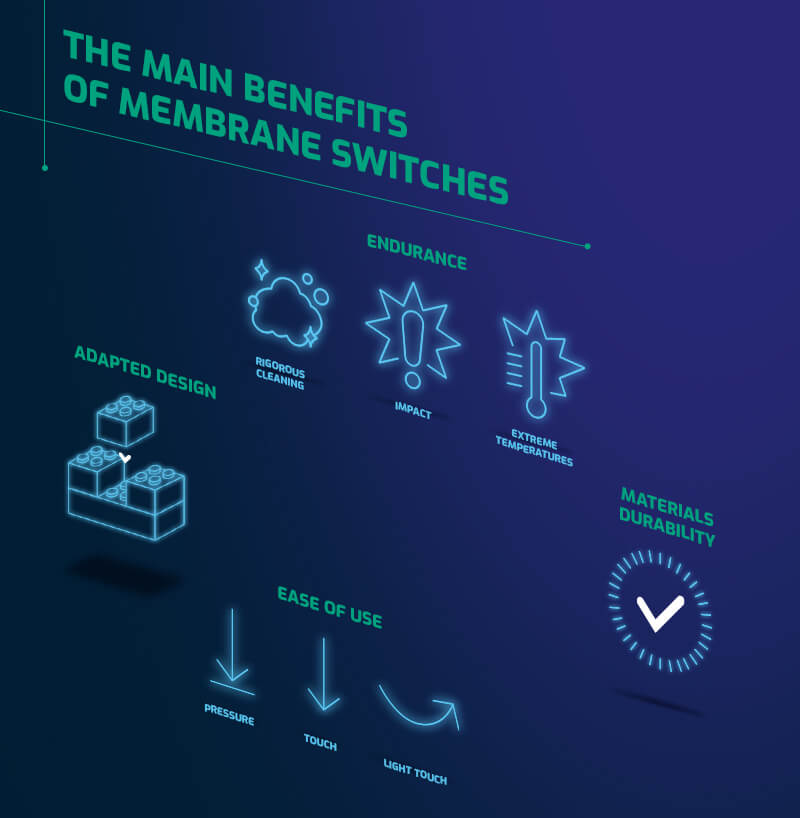The Production Refine Behind Membrane Change: What You Need to Know
The production process behind membrane layer switches combines mindful style, material choice, and quality control. It starts with understanding the ins and outs of membrane button style and proceeds with numerous stages, consisting of product options and printing strategies. Each stage plays an important duty in guaranteeing capability and resilience. The complexities of layer building and construction and the strenuous testing criteria might reveal insights that are not quickly apparent. What lies past these fundamental aspects?
Understanding Membrane Layer Change Layout
Membrane layer buttons might appear basic at initial look, their layout entails intricate considerations that guarantee functionality and sturdiness. The style process starts with a comprehensive understanding of individual demands, including the interface's designated application and environmental aspects. Comfort designs is a vital component, as the format has to promote ease of use while ensuring that tactile responses fulfills customer expectations.Moreover, the layering of elements, such as graphic overlays, adhesive layers, and conductive traces, should be exactly engineered. membrane switch. This split arrangement not just influences the switch's responsiveness yet additionally influences its long life. Interest is offered to the sealing methods used to secure versus wetness and dust, which could endanger performance. Additionally, design factors to consider include appearances, where color design and aesthetic clearness enhance customer experience. Eventually, the design of membrane switches equilibriums performance, user experience, and durability, making certain that they satisfy the demands of numerous applications efficiently
Products Utilized in Membrane Layer Change Manufacturing
When choosing materials for membrane layer switch production, it is necessary to consider both efficiency and sturdiness. The key materials consist of polyester and polycarbonate films, which provide versatility and toughness. These films are often coated with glue to guarantee correct bonding to substrates. Conductive inks, commonly composed of silver or carbon, are essential for producing electric connections within the switch, permitting dependable operation.Additionally, a safety layer, such as a hard layer, is frequently applied to enhance scrape resistance and longevity. The option of backing product, such as acrylic or foam, can significantly impact the button's responsive feel and general customer experience. Different ecological elements, consisting of temperature level and humidity, ought to assist product option to guarantee peak performance in particular applications. Eventually, the appropriate mix of materials adds to the membrane switch's performance and life expectancy, making educated selections essential for suppliers.
The Printing Refine: Creating Video and Text
The printing procedure in membrane layer button production plays a substantial duty in generating top notch graphics and message. Numerous visuals style methods are utilized to ensure visual appeal and performance, while mindful ink selection methods are important for sturdiness and performance. Comprehending these components is essential for accomplishing finest cause membrane button style.
Graphic Style Techniques
Graphic design techniques play an essential duty in the printing process of membrane layer buttons, as they define just how graphics and message will inevitably appear on the end product. Effective visuals design entails the calculated use fonts, layouts, and shades to enhance readability and visual appeal. Designers commonly use vector graphics for scalability, guaranteeing that photos remain sharp at numerous sizes. In addition, interest to comparison and alignment is essential, as it influences individual communication and aesthetic top quality. The consolidation of branding elements, such as logos, have to be handled with treatment to keep brand stability. On the whole, thoughtful graphic style techniques contribute significantly to the capability and beauty of membrane layer buttons, impacting individual experience and item efficiency.
Ink Choice Methods
Selecting the ideal ink is necessary for accomplishing the desired visual high quality and resilience in membrane layer button manufacturing. Numerous ink types are utilized, including solvent-based, water-based, and UV-curable inks. Each type uses distinctive features, such as adhesion, flexibility, and resistance to environmental elements. Solvent-based inks are typically favored for their toughness and vivid shades, while water-based inks are more eco-friendly but might have constraints in attachment. UV-curable inks give quick curing and durable efficiency. In addition, shade matching methods ensure that the selected inks align with layout requirements. Ultimately, the selection of ink have to take into consideration aspects such as application technique, substrate compatibility, and end-use requirements to attain premium cause membrane layer switch graphics and text.
Layer Building And Construction and Setting Up

Product Option Process
A careful selection of materials is necessary in the production process of membrane switches, as it directly influences functionality and sturdiness. The main products utilized consist of polyester, polycarbonate, and numerous conductive inks. Polyester is often favored for its outstanding resistance to chemicals and abrasion, making it suitable for severe atmospheres. Polycarbonate, on the other hand, offers exceptional clarity and impact resistance, which is useful for applications needing exposure and toughness. Conductive inks, usually composed of silver or carbon, are important for creating dependable electrical paths. In addition, the option of sticky materials impacts the total honesty of the button - membrane switch. Examining elements such as environmental direct exposure, responsive responses, and aesthetic demands overviews makers in choosing the very best products for their details applications
Layer Bond Strategies
Adhering layers in membrane button building is an important process that assures performance and longevity. Numerous adhesion methods are employed to safeguard suitable bonding between layers, which typically consist of the use of adhesives, warm, and stress. Pressure-sensitive adhesives (PSAs) are typically utilized for their ease of application and immediate bonding abilities. Additionally, thermal bonding strategies can be applied, where warmth is used to turn on adhesive residential or commercial properties, safeguarding a strong bond. The choice of bond approach mostly relies on the materials entailed and the particular application needs of the membrane switch. Correct positioning and consistent application of adhesives are necessary to protect against defects, securing the switch runs effectively throughout its intended life-span.
High Quality Control Procedures
Guaranteeing quality assurance during the layer building and construction and assembly of membrane buttons is crucial for preserving efficiency and reliability. This procedure normally includes numerous vital procedures, consisting of comprehensive assessments at each phase of manufacturing. Manufacturers utilize innovative testing methods, such as peel tests and bond evaluations, to confirm the honesty of layer bonds. In addition, aesthetic examinations are conducted to determine any type of flaws in printing or material inconsistencies. Ecological problems, such as temperature and moisture, are very carefully monitored to guarantee suitable treating and attachment. Normal calibration of tools assists preserve accurate manufacturing standards. By implementing these quality control steps, producers can significantly decrease the risk of item failing, ensuring that the final membrane layer switches over satisfy the required specifications and consumer assumptions.
Evaluating and Quality Control Measures

Developments in Membrane Layer Switch Over Innovation
As advancements in modern technology proceed to develop, membrane layer buttons are gaining from cutting-edge advancements that enhance their capability and individual experience. One notable advancement is the combination of capacitive touch modern technology, which enables more instinctive and receptive user interfaces. This change not only enhances look at this website aesthetic appeals but likewise reduces mechanical damage, extending the life-span of the switches.Additionally, advancements in visuals overlay products have brought about improved longevity and resistance to environmental variables such as moisture and UV light. These products currently provide boosted clarity and brightness, more raising the aesthetic appeal.Furthermore, the incorporation of wise modern technology is transforming membrane switches over right into interactive control panels, allowing connection with IoT devices. This connectivity cultivates a seamless individual experience, leading the way for applications in various markets, from medical care to customer electronics. Collectively, these advancements placement membrane layer switches as important parts in modern device style.
Often Asked Inquiries
The length of time Does the Membrane Switch Manufacturing Process Take?
The duration of the membrane button production procedure can differ substantially. Factors such as complexity, materials used, and production volume influence timelines, with common production ranging from a few days to a number of weeks for completion.
What Are the Typical Applications for Membrane Switches?
Membrane switches are typically utilized in various industries, including automotive controls, household appliances, medical devices, and consumer electronics (membrane switch). Their convenience and go to this web-site durability make them ideal for applications requiring user-friendly user interfaces and trusted efficiency in varied atmospheres
Can Membrane Switches Be Customized for Specific Demands?
What Is the Life-span of a Typical Membrane Change?
The life expectancy of a regular membrane layer button differs, but generally, it ranges from 1 to 5 million cycles. Elements such as usage, environment, and material quality significantly influence toughness and total efficiency with time.

Are Membrane Switches Over Eco Pleasant?
The ecological friendliness of membrane switches varies. Some materials used may not be recyclable, while others can be environmentally friendly. The overall effect depends upon producing practices and products, requiring cautious consideration during selection and disposal. The production process behind membrane switches over combines mindful design, product option, and high quality control. It begins with recognizing the intricacies of membrane layer switch layout and advances through numerous phases, including product options and printing strategies. When choosing materials for membrane layer switch production, it is necessary to consider both efficiency and toughness. A careful option of materials is essential in the production browse around here process of membrane layer switches, as it straight influences capability and sturdiness. The selection of bond approach mostly depends on the products involved and the details application requirements of the membrane layer switch.
Comments on “The complete guide about membrane switch customization”